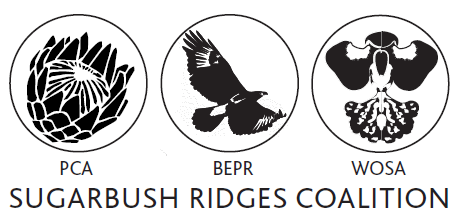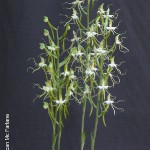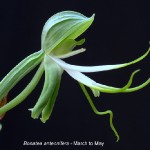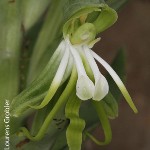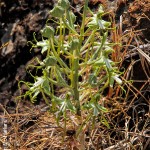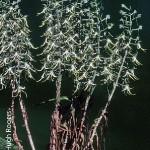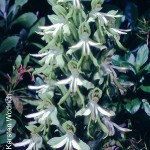Bonatea
The genus Bonatea comprises of 13 species that are mostly endemic to Africa with one exception that is found in the Arabian Peninsula. 10 species are found in South Africa. Plants have soft tuberous root systems or ovoid tuberoids. The terminal inflorescence with green and white flowers is borne on leafy stem (with some species leaves brown at flowering time). Flowers are very distinct and the genus is related to Habenaria. Most species are scented at night and are most likely pollinated by moths.
Credit
Johnson, S.D., Bytebier, B., Stärker, H. (2010). Orchids of South Africa: A field guide. Struik Nature, Cape Town, South Africa.
Bonatea antennifera
Description
Robust terrestrial up to 1.2 m tall. Leaves 6-21, cauline, oblong to broadly spear-shaped, up to 190 mm long. Inflorescence lax to dense, 4-44 flowers, green and white, median sepal erect, up to 23 mm long, lateral sepals deflexed, up to 26 mm long, petals divided, upper lobe linear, up to 24 mm long, lower lobe narrowly linear throughout, projecting forward and ascending, up to 43 mm long, lip 3-lobed from a short and narrow base, mid-lobe narrowly linear, sharply bent near the middle, up to 34mm long, side-lobes narrowly linear with apex recurved, up to 45 mm long, spur somewhat swollen towards apex, up to 44 mm long. Similar to Bonatea boltonii, but distinguished by the forward projecting, lower petal lobes and the stigmatic arms which are club-shaped. Also similar to Bonatea speciosa, but distinguished by the shorter (less than 15 mm) club-shaped apex of the spur and lower petal lobe less than 2 mm wide.
Syn: Bonatea speciosa var. antennifera.
Bonatea boltonii
Description
Slender terrestrial of variable height, from 100 mm to 750 mm. Leaves 5-13, cauline, oblong to broadly spear-shaped, up to 178 mm long.The numbers of flowers is similarly variable, between 3 and 20. Leaves are cauline and broadly spear shaped. Inflorescence is the continuation of the stem. Flowers are green and white. Median sepal erect, up to 19 mm long. Lateral sepals slightly deflexed, up to 20 mm long. Petals divided, upper petal lobe up to 18 mm long. Lower petal lobe linear, spreading horizontally. Lip 3-lobed, from a short and narrow base. Spur somewhat swollen towards apex, up to 51 mm long. Similar to Bonatea antennifera but has shorter stigmatic arms with a spatula-shaped, deflexed stigma and Bonatea speciosa where it has a shorter club-shaped spur apex.
Bonatea cassidea
Description
Slender terrestrial, up to 640 mm tall. Leaves 5-13, cauline and spear shaped, sometimes withered at flowering time. Inflorescence is by way of a continuation of the stem and carries up to 35 flowers, which are green and white, where the lip midlobe and petal lobes are white in western populations and green in eastern populations. Spur up to 26mm long. Pollinated by butterflies. Syn: Bonatea saundersiae.
Bonatea lamprophylla
Description
Robust terrestrial up to 1m tall. Leaves 5-15 cauline with wavy margin, egg-shaped, up to 130mm long and 75mm wide. Inflorescence lax, 5-16 flowers, which are green and white.
Bonatea polypodantha
Description
Slender terrestrial up to 330 mm tall. Leaves 4-8, basal leaves 1-3, broadly elliptic, up to 120 mm. Cauline leaves 2-5, spear shaped and much smaller than basal leaves. Inflorescence lax, carrying 2-12 flowers, which are pale green and white. Characterised by the lower petal lobe, which is long, thread-like and curved.
Bonatea porrecta
Description
Fairly robust terrestrial, which can grow up to 560 mm tall. Leaves 5-16, cauline, narrowly oblong, up to 130 mm long and withered at flowering time. Inflorescence lax, carries 3-36 flowers, which are green and white.
This species is different to all others in Gauteng in that flowering commences between late June after the leaves have withered in the dry winter conditions. The plant starts growing a new shoot beside the old flowering shoot as soon as it starts raining in early summer and continues until late autumn, when it is in full leaf and commences the start of the terminal inflorescence. The leaves have fully withered by mid May.
Bonatea pulchella
Description
Slender terrestrial up to 320mm tall. Leaves 5-9, basal leaves in a rosette of 2-5, cauline leaves few and narrowly spear-shaped. Inflorescence lax, with 2-11 flowers, which are white and back of sepals and spur green. Median sepal erect, petals divided, lip 3-lobed from a narrow base, spur swollen towards apex, up to 70mm long.
Bonatea saundersioides
Description
Slender terrestrial of up to 600mm tall. Leaves 5-12 cauline, elliptic and may have started to wither when flowering. Inflorescence lax, 4-41 flowers, which are green and white.
Bonatea speciosa
Description
Robust terrestrial, up to 950mm tall. Leaves 4-19 cauline, oblong to broadly spear-shaped and up to 155mm long. Inflorescence rather dense, with up to 40 flowers, which are green and white. Previously related to Bonatea antennifera which was known as Bonatea speciosa var. antennifera, while this species was known as Bonatea speciosa var. speciosa. Both varieties have now been recognised as species in their own right. Scented at dusk and pollinated by hawkmoths.
Bonatea steudneri
Description
Robust terrestrial up to 1m tall. Leaves 7-20, cauline, elliptic to spear-shaped and up to 154mm long. Inflorescence lax, 5-35 flowers, green and white in colour.
For more information regarding the preservation of South Africa's wild Orchids or if you would like to get involved please email This email address is being protected from spambots. You need JavaScript enabled to view it. or complete this short form Contact Us and we will contact you.
